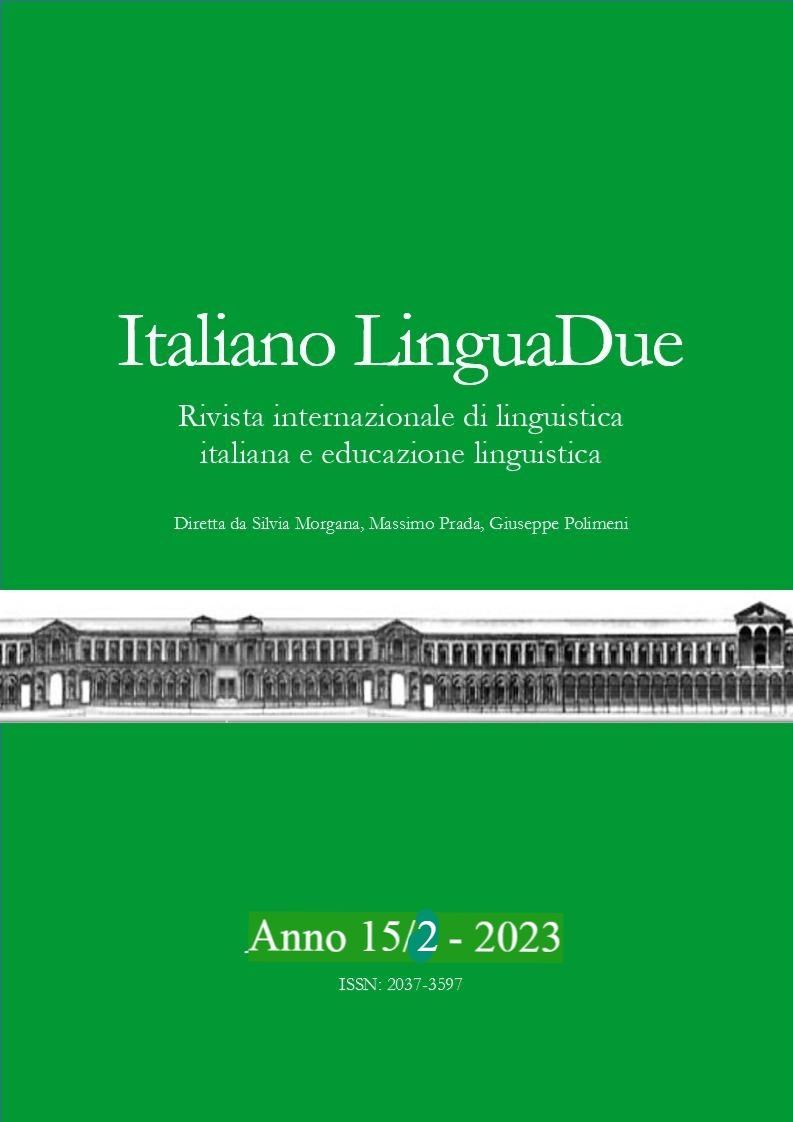RIFLESSIONI DI STUDENTI DI L1 SLOVACCA SUL TEMPO E L’ASPETTO IN ITALIANO: UNO STUDIO DI CASO
DOI:
https://doi.org/10.54103/2037-3597/21942Abstract
Lo studio indaga le riflessioni sul tempo e sull’aspetto fatte da studenti universitari che hanno come L1 lo slovacco come L3 l’italiano. Utilizzando metodi misti qualitativi e quantitativi, offre un’analisi approfondita delle argomentazioni fornite dagli studenti. Descrive le differenze nell’uso delle strategie cognitive di apprendimento grammaticale (riflessione metalinguistica, traduzione, intuizione) in relazione alla complessità delle caratteristiche aspettuali delle frasi analizzate. L’approccio sperimentale presenta la prospettiva dell’apprendente, in quanto offre frasi grammaticali e agrammaticali per studiare le opinioni sulla correttezza o scorrettezza di esempi dati in italiano come lingua straniera. L’articolo propone innovazioni nel disegno della ricerca per consentire interrogazioni contrastive specializzate in ulteriori ricerche sull’apprendimento del tempo verbale e dell’aspetto nell’italiano L3 da parte di apprendenti di L1 slovacca. La ricerca è stata condotta nell’ambito di un seminario sperimentale multilingue.
Reflections of L1 Slovak students on tense and aspect in Italian: a case study
The study investigates the tense and aspect reflections by Slovak L1 university students in L3 Italian. Using mixed qualitative and quantitative methods, it offers an in-depth analysis of the arguments provided by students. It describes differences in the use of cognitive grammar learning strategies (metalinguistic reflection, translation, intuition) concerning the complexity of the aspectual characteristics of the analyzed sentences. The experimental approach addresses the learner’s perspective, as it offers both grammatical and ungrammatical sentences to study views on the correctness or incorrectness of given examples in Italian as a foreign language. The paper proposes innovations in research design to permit specialized contrastive queries in further research of tense and aspect learning of L3 Italian by L1 Slovak learners. The research was conducted as part of a multilingual experimental seminar.
Riferimenti bibliografici
Bardel C., Falk Y. (2020), “L1, L2 and L3: Same or different?”, in Second Language Research, XXXVII, 3, pp. 459-464. DOI: https://doi.org/10.1177/0267658320941033
Bardovi-Harlig K., Comajoan-Colomé L. (2022), “The relation of second language acquisition, instructed second language acquisition, and language teaching from the lens of second language tense-aspect”, in Language Teaching, LV, 3, pp. 289-345. DOI: https://doi.org/10.1017/S026144482200009X
Comajoan L. (2019), “Cognitive grammar learning strategies in the acquisition of tense-aspect morphology in L3 Catalan”, in Language Acquisition, XXVI, 3, pp. 262-281. DOI: https://doi.org/10.1080/10489223.2018.1534965
Comrie B. (1976), Aspect. An introduction to the study of verbal aspect and related problems, Cambridge University Press, Cambridge.
Derakhshan A., Malmir A., Pawlak M., Wang Y. (2023), “The Use of Interlanguage Pragmatic Learning Strategies (IPLS) by L2 Learners: The Impact of Age, Gender, Language Learning Experience, and L2 Proficiency Levels”, in International Review of Applied Linguistics in Language Teaching, pp. 1-24. DOI: https://doi.org/10.1515/iral-2022-0132
Dister A. (2022), “Maurice Grevisse et André Goosse: du bon usage au français universel”, in Cahiers internationaux de sociolinguistique, XXI, pp. 129-145. DOI: https://doi.org/10.3917/cisl.2202.0129
Dörnyei Z., Ryan S. (2015), The Psychology of the Language Learner Revisited, Routledge, New York. DOI: https://doi.org/10.4324/9781315779553
Dziviaková M. (2022), “Lexikálno-gramatická kategória slovesného vidu v súčasnej spisovnej slovenčine”, in Philologia, XXXII, 2, pp. 193-220.
Gavora P. (2015), “Obsahová analýza v pedagogickom výskume: Pohľad na jej súčasné podoby”, in Pedagogická orientace, XXV, 3, pp. 345-371. DOI: https://doi.org/10.5817/PedOr2015-3-345
Gregersen T., MacIntyre P. D. (2014), Capitalizing on Language Learners’ Individuality: From Premise to Practice, Multilingual Matters, Bristol. DOI: https://doi.org/10.21832/9781783091218
Hofer B. (2015), A Multilingual Development Framework for Young Learners, De Gruyter, Berlin, Boston.
Kuckartz U., Rädiker S. (2019), Analyzing Qualitative Data with MAXQDA, Springer, New York. DOI: https://doi.org/10.1007/978-3-030-15671-8
Lojová G., Vlčková K. (2011), Styly a strategie učení ve výuce cizích jazyků, Portál, Praha.
Oxford R. L. (2017), Teaching and Researching Language Learning Strategies, Routledge, New York. DOI: https://doi.org/10.4324/9781315719146
Pawlak M. (2017), “Overview of learner individual differences and their mediating effects on the process and outcome of interaction”, in Gurzynski-Weiss L. (ed.), Expanding individual difference research in the interaction approach: Investigating learners, instructors, and other interlocutors, John Benjamins, Amsterdam, pp. 19-40. DOI: https://doi.org/10.1075/aals.16.02paw
Pawlak M. (2021), “Investigating language learning strategies: Prospects, pitfalls and challenges”, in Language Teaching Research, XXV, 5, pp. 817-835. DOI: https://doi.org/10.1177/1362168819876156
Pawlak M., Csizér K. (2023), “Investigating the Use of Grammar Learning Strategies in Hungary and Poland: A Comparative Study”, in Applied Linguistics, XXXXIV, 2, pp. 347-369. DOI: https://doi.org/10.1093/applin/amac038
Pinto M. A., Iliceto P. (2007), TAM-3. Test di abilità metalinguistiche n.3. Fascia adolescenti-adulti, Carocci, Roma.
Smith C. S. (1983), “A theory of aspectual class”, in Language, LIX, pp. 479-501. DOI: https://doi.org/10.2307/413899
Smith C. S. (1997), The parameter of aspect, Kluwer Academic, Dordrecht, Boston, London.
Toth Z. (2019), “Tense and Aspect in L3 Interlanguage. The Effect of Lexical Aspect and Discourse Grounding on the Development of Tense and Aspect Marking in L3 Italian”, in Vetter E., Jessner U. (eds.), International Research on Multilingualism: Breaking with the Monolingual Perspective. Multilingual Education, Springer, Cham, pp. 233-254. DOI: https://doi.org/10.1007/978-3-030-21380-0_13
Toth Z. (2020), Tense and Aspect in Italian Interlanguage, De Gruyter, Berlin, Boston. DOI: https://doi.org/10.1515/9783110626490
Toth Z., Medveczká M., Štrbáková R., Bojničanová R. (2022), “Viacjazyčný seminár a jazyková angažovanosť študentov”, in Philologia, XXXII, 2, pp. 265-278.
Toth Z., Malovecký M., Medveczká M. (2021), “Learning and Teaching Romance Languages as L3. Ideas, Questions, Challenges”, in Studies in foreign language education, 13, Kirsch-Verlag, Nümbrecht, pp. 220-238.
Vallerossa F. (2022), “‘I think mangiò might be passé simple’: exploring multilingual learners’ reflections on past tense verb morphology”, in International Journal of Multilingualism, pp. 1-19. DOI: https://doi.org/10.1080/14790718.2022.2036159
Dowloads
Pubblicato
Fascicolo
Sezione
Licenza
Copyright (c) 2023 Italiano LinguaDue

Questo lavoro è fornito con la licenza Creative Commons Attribuzione - Condividi allo stesso modo 4.0.




